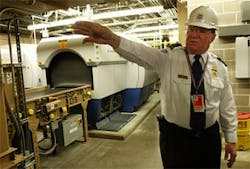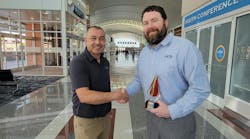GRAPEVINE, Texas (AP) -- The cardboard box marked ''LCD TV - Delicate'' came sliding down the conveyer belt in the underbelly of Terminal E and was hoisted aside by Hansen Le, a federal baggage screener.
Le glanced at an X-ray of the box, sliced it open and removed packing material to peer inside. He swabbed inside the box and tested the sample in a machine that detects bomb residue.
Pronouncing the unwieldy package OK, Le and another screener quickly taped it up and loaded it on another belt, which whisked it to a waiting Continental Airlines jet.
The box was one of the first pieces of luggage to be pulled aside Monday as it went through a new $220 million, post-9-11 security system at Dallas-Fort Worth International Airport. Federal officials said when the automated system is complete, it will be the largest in the world.
Unlike the stand-alone, minivan-size detection machines that were plopped down in airport lobbies after the 2001 terror attacks, the new setup is part of the airlines' bag-handling system.
At DFW, one of the nation's busiest airports, the system will eventually handle all 55,000 bags checked every day, taking them from curbside or ticket counters to screening rooms out of public view.
It will end the need for travelers to schlep their bags to a security checkpoint and wait while their luggage is examined.
The federal government will pay $185 million of the system's $220 million cost, with the airport paying the balance. The government is also reimbursing eight other airports for similar systems.
A federal report issued last month suggested it was money well spent. The report by the Government Accountability Office estimated that automated system at DFW would save the Transportation Security Administration about $250 million over seven years, mostly by screening bags twice as fast and with far fewer screeners.
Workers will only handle bags that are earmarked for extra attention by a combination X-ray and CAT scan machine.
Robert Gentry, an engineer with the TSA, said the technology will flag for closer inspection 19 percent of bags on domestic flights and 25 to 28 percent on international flights. Bags that trigger an alarm are automatically shunted off to the ''resolution room,'' where they are searched by a half-dozen TSA screeners.
Hand inspections will be quicker too, said William Smith, a TSA supervisor at DFW, because the CAT scan yields a three-dimensional picture of the inside of the bag, letting the screener go right to the suspicious item inside - ''whether it's a bomb or peanut butter.''
DFW is using two types of bomb-detecting machines. It will eventually have 47 large explosive-detection systems, or EDS, which look and work like a car-size version of magnetic-resonance imaging devices used in hospitals.
The airport will also get 104 explosives-trace detection, or ETD machines, each about the size of a clothes dryer. Screeners use a wand to swab the bag, then put the swab in the ETD machine to detect bomb residue.
The automated bag-scanning system for Continental flights went into operation Sunday. Similar equipment is scheduled to be installed by August in three of DFW's four other terminals, including a new international terminal.
Construction has not begun in Terminal A, used by American Airlines, American Eagle and Grupo Taca, a discount carrier serving Latin America.





